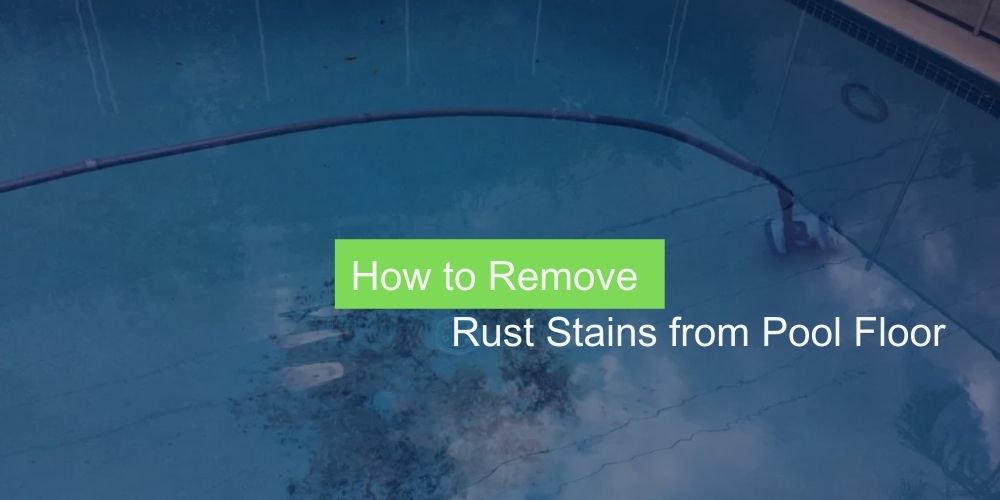
Rust stains on the pool floor are a common issue faced by pool owners and can be quite frustrating. Not only do these stains affect the pool’s overall appearance, but they can also indicate underlying corrosion and potential damage.
Removing rust stains from the pool floor is essential for both aesthetic purposes and the longevity of the pool’s structure.
In this post, we will explore effective methods and techniques to help you successfully eliminate rust stains and restore the beauty of your pool. The guide will ensure you have a clean and inviting pool environment for yourself and your guests.
6 Steps to Eliminate Rust Stains from Your Pool Floor

1. Gathering all the necessary tools and materials
Before you begin the process of removing rust stains from your pool floor, it is important to gather all the necessary materials.
Here’s a list of items you will need:
- Pool Brush: Choose a soft-bristle brush specifically designed for pool surfaces. Avoid using abrasive brushes that can damage the pool floor.
- Rust Stain Remover: Look for a rust stain remover that is safe and effective for pool use. There are various products available in the market specifically formulated to eliminate rust stains.
- Protective Gloves: Wear rubber or chemical-resistant gloves to protect your hands while handling cleaning chemicals and to prevent skin irritation.
- Safety Goggles: Protect your eyes from any potential splashes or fumes by wearing safety goggles during cleaning.
- Pool Skimmer or Net: A pool skimmer or net will come in handy to remove any debris or loose rust particles from the water surface before and after the cleaning process.
- Chemical-resistant Bucket: You’ll need a bucket to mix cleaning solutions or dilute rust stain removers. Choose a bucket that is resistant to the chemicals you’ll be using.
- pH Testing Kit: It’s important to monitor the pH level of your pool water throughout the cleaning process. A pH testing kit will help you ensure the water chemistry remains balanced.
- Pool Vacuum or Pool Pump: If you choose to drain the pool completely, a pool vacuum or pump will be necessary to remove the water efficiently. However, if you prefer to lower the water level, a submersible pump can help.
- Cleaning Agents: Depending on the type of rust stain remover you’re using, you may need additional cleaning agents such as citric acid, oxalic acid, or a mild pool cleaner.
- Water Hose: A water hose will be required for rinsing the pool floor and maintaining a clean work area.
2. Prepare The Pool For The Task
Before you start the process of removing rust stains from your pool floor, it’s important to prepare the pool properly. Follow these steps to ensure a smooth and effective cleaning process:
- Lower the Water Level: If you prefer not to drain the entire pool, lower the water level to expose the stained areas. Use a submersible pump or pool vacuum to reduce the water level to a few inches below the stains. This will make the cleaning process more manageable.
- Protect Surrounding Areas: Rust stain removers and cleaning agents can be corrosive and may damage surrounding surfaces or vegetation. Before you begin, cover any nearby plants, furniture, or other sensitive areas with plastic sheets or tarps to prevent accidental contact.
- Safety Precautions: Ensure you have a well-ventilated area to work in. If you’re using chemical cleaners, wear protective gloves and safety goggles to safeguard your skin and eyes. Follow the manufacturer’s instructions regarding the safe usage and disposal of the cleaning agents.
- Empty Skimmer and Remove Debris: Before you start cleaning, use a pool skimmer or net to remove any debris, leaves, or loose rust particles from the pool surface. This will help prevent them from settling back onto the floor during cleaning.
- Turn off Equipment: It’s important to turn off the pool pump and any other equipment that circulates water to avoid stirring up the rust particles and spreading them further.
- Check for Pool Surface Damage: Before proceeding, inspect the pool floor for any cracks, chips, or damage. If you notice significant damage, it’s advisable to consult a professional to assess and repair it before proceeding with the rust stain removal process.
3. Identify and Treat Rust Stains
To effectively remove rust stains from your pool floor, you need first to identify the type and severity of the stains. This will help you choose the appropriate treatment method.
Follow these steps to identify and treat rust stains:
- Inspect the Pool Floor: Carefully examine the pool floor to locate the rust stains. They typically appear as reddish-brown or orange discolorations on the surface. Look for areas where metal objects or components come into contact with the pool floor, such as ladders, handrails, or drains, as these are common areas for rust stains to develop.
- Surface Rust Stains: If the rust stains are superficial and have not penetrated the pool floor, they can often be treated with a mild rust stain remover or a combination of water and mild detergent. Follow the instructions provided with the rust stain remover, and apply it to the stained areas using a soft brush or sponge. Gently scrub the stains in a circular motion until they start to fade away. Rinse the area thoroughly with clean water.
- Embedded Rust Stains: If the rust stains have penetrated the pool floor or are deeply embedded, they may require a stronger treatment approach. One option is to use a specialized rust stain remover formulated for tougher stains. These products usually contain stronger chemicals like oxalic acid or citric acid. Mix the rust stain remover with water according to the instructions, and apply it to the stains. Allow the solution to sit on the stains for the recommended amount of time, then scrub the area with a soft brush or sponge. Rinse the treated area thoroughly to remove any residue.
- Stubborn and Deep-Seated Rust Stains: In some cases, stubborn rust stains may still persist after using conventional rust stain removers. For such stains, you can try using a pumice stone or a rust eraser specifically designed for pool use. Wet the stone or eraser and gently rub it over the stains, applying light pressure. Be cautious not to scrub too vigorously or use abrasive materials that could damage the pool floor. Rinse the area well to remove any residue.
- Repeat the Process: For particularly stubborn rust stains, you may need to repeat the treatment process several times until the stains are fully eliminated. Be patient and persistent in your efforts, and continue treating the affected areas until the desired results are achieved.
4. Scrub and Clean the Pool Floor
After treating the rust stains on your pool floor, thoroughly scrub and clean the surface to remove any remaining residue and ensure a clean, stain-free pool is next.
Follow these steps for effective scrubbing and cleaning:
- Select Suitable Brushes or Scrubbers: Choose a brush or scrubber that is appropriate for your pool surface. A nylon-bristle brush is generally safe for concrete or plaster surfaces. Opt for a soft-bristle brush or a scrubber specifically designed for vinyl or fiberglass surfaces. Avoid using abrasive brushes or scrubbers that can damage the pool floor.
- Scrub in Sections: Divide the pool floor into manageable sections and focus on one area at a time. Dip the brush or scrubber into the water and gently scrub the pool floor in a circular motion. Apply moderate pressure to remove any residual stains or cleaning solution. Work systematically, moving from one section to the next until the entire pool floor is scrubbed.
- Use Appropriate Cleaning Agents: Depending on the type of pool floor and any remaining stains, you may need to use a mild pool cleaner or a solution of water and mild detergent to aid in the cleaning process. Follow the manufacturer’s instructions for diluting the cleaner or detergent and applying it to the pool floor as needed. Avoid using harsh chemicals or abrasive cleaners that can damage the surface.
- Pay Attention to Corners and Hard-to-Reach Areas: Rust stains can accumulate in corners, around drains, or other hard-to-reach areas of the pool floor. Use a smaller brush or scrubber to reach these spots and ensure thorough cleaning. Take your time and be diligent in scrubbing all areas of the pool floor.
- Rinse the Pool Floor: Thoroughly rinse the pool floor with clean water after scrubbing. Use a hose or a bucket to pour water onto the surface, directing it towards the pool drain or skimmer. This will help remove any loosened debris, residual cleaning agents, or remaining stain particles.
- Repeat the Process if Needed: If any stubborn stains or residue persist, you may need to repeat the scrubbing and cleaning process. Apply the appropriate cleaning agent or rust stain remover to the specific areas, and scrub again using the same techniques mentioned above. Rinse thoroughly after each application.
5. Neutralize Chemical Residues and Rinse
After scrubbing and cleaning the pool floor to remove rust stains, it is crucial to neutralize any chemical residues and thoroughly rinse the pool to maintain proper water chemistry. Follow these steps to neutralize chemicals and ensure a clean pool environment effectively:
- Neutralize Cleaning Chemicals: Some cleaning agents or rust stain removers may leave behind chemical residues that can affect the pool water chemistry. To neutralize these residues, follow the instructions provided with the cleaning products. Typically, this involves adding a specific chemical neutralizer to the pool water. Be sure to use the recommended amount based on your pool’s volume.
- Test and Adjust pH Level: After neutralizing any chemical residues, test the pH level of your pool water using a pH testing kit. The ideal pH range for pool water is typically between 7.2 and 7.6. If the pH is too high or too low, adjust it accordingly by adding a pH increaser or pH decreaser as needed. Follow the manufacturer’s instructions and retest the water until the pH is within the appropriate range.
- Thoroughly Rinse the Pool: Once the chemical residues are neutralized, and the pH is balanced, it’s time to rinse the pool floor and the entire pool thoroughly. Use a hose or a bucket to pour clean water onto the pool floor and direct it towards the pool drain or skimmer. Rinse all areas of the pool, including walls and any other surfaces that may have come into contact with cleaning agents or residue.
- Remove Excess Water: If you lowered the water level before cleaning, you can refill the pool to the appropriate level. If you fully drain the pool, remove all the rinse water before refilling. Use a pool vacuum or pump to remove any remaining water, or allow it to drain completely if necessary.
- Monitor Water Quality: After the rinsing process, monitor the water quality regularly to ensure it remains balanced and clear. Test the water for pH, chlorine levels, and other necessary parameters based on your pool’s specific requirements. Make any necessary adjustments to maintain proper water chemistry and clarity.
6. Prevent Future Rust Stains
Preventing future rust stains in your pool is essential to maintain its appearance and structural integrity. Follow these tips to minimize the risk of rust stains and keep your pool in top condition:
- Monitor and Maintain Water Chemistry: Proper water chemistry is crucial in preventing rust formation. Regularly test and balance your pool water’s pH, alkalinity, and calcium hardness levels. This helps prevent corrosion of metal components and reduces the likelihood of rust stains.
- Keep Metal Objects Clean and Coated: Metal objects such as ladders, handrails, and fixtures should be regularly cleaned and coated with a protective layer to prevent rust. Use a metal cleaner and apply a rust-resistant coating or paint specifically designed for pool use. This helps protect the metal surfaces and reduces the chances of rust stains.
- Address Water Imbalance and Stagnation: Imbalanced water chemistry, especially high levels of iron or other metals, can contribute to rust stains. Promptly address any water imbalances and treat them accordingly. Additionally, stagnant water can accelerate the formation of rust stains. Regularly circulate the pool water using the pool pump and ensure proper water filtration.
- Regular Pool Maintenance: Keep up with routine pool maintenance to prevent rust stains. Clean the pool regularly, promptly remove debris, and vacuum the floor as needed. Regular maintenance helps prevent the accumulation of rust-causing particles and maintains a clean pool environment.
- Avoid Using Metal Brushes: When cleaning the pool floor or surfaces, avoid using metal brushes or abrasive cleaning tools that can scratch or damage the pool finish. Opt for soft-bristle brushes or scrubbers specifically designed for pool use to prevent any potential damage that could lead to rust stains.
- Regular Inspection of Pool Components: Regularly inspect all metal components of your pool, including ladders, handrails, drains, and fittings. Look for signs of corrosion, rust, or wear. Address any issues promptly by repairing or replacing damaged or rusted parts.
Finally
Removing rust stains from your pool floor requires thorough preparation, proper identification of the stains, and effective treatment methods.
If you follow the outlined steps include preparing the pool, identifying and treating the stains, scrubbing and cleaning the pool floor, neutralizing chemical residues, and preventing future rust stains, you can restore the pristine condition of your pool and maintain its beauty for years to come.
You also need to prioritize regular maintenance and water chemistry to prevent the recurrence of rust stains and enjoy a clean and inviting pool environment.

Hi, This is Josh. I am a former competitive swimmer and current fitness enthusiast.
I created this site to share my love of swimming with the world!
